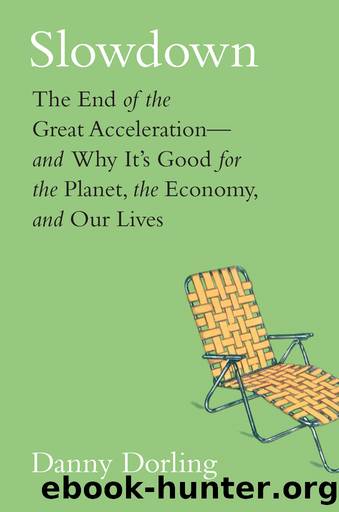Slowdown by Danny Dorling

Author:Danny Dorling [Dorling, Danny]
Language: eng
Format: epub
Publisher: Yale University Press
Published: 2020-07-14T16:00:00+00:00
35. United States: total fertility rate, 1973–2016. (World Bank Open Data, fertility rate, estimates based on the 2017 UN World Population Prospects and other sources, https://data.worldbank.org/indicator/sp.dyn.tfrt.in.)
From 1990 to 2005, the track of the timeline in figure 35 looked as if it had settled again, returning to 2.1 children per American woman—the rate last seen an entire generation earlier, back in the very early 1970s. But then something dragged it rapidly down. That something was global; it was the result of what was happening at this time outside of the United States. Immigrants to the United States were coming from places where it was now usual to have fewer children, and they had even fewer when they arrived. Hardly anywhere on Earth now appears able to buck the global slowdown trend. Since 2007, total fertility in the United States has fallen every year, heading faster and faster downward.
THE SLOWDOWN IS A RETURN TO MORE STABLE GENERATIONS
It was only in the last quarter-century of 1820–1926, that long slow period of the first global population doubling, that improvements in child health became a significant part of the reason for the overall population growth. Before then, it was social dislocation associated with rising trade and urbanization that led people to have more children, although not necessarily healthier children. Around 1901, all that changed very quickly, not least because of the discovery of germ theory in the preceding decades, for which Robert Koch was awarded a Nobel Prize in 1905.
The first Nobel Prize (of all) had been awarded four years earlier, in 1901, partly because people had begun to see themselves differently. Achievements are almost always a collective effort, but we were entering an era in which a few individuals would annually be celebrated as being extraordinarily special (remember, eugenics was then still popular). That is something else that might soon alter as we slow down. You should in future expect to see prizes more often awarded to larger groups than to single individuals.
Generations are often thought of as being around twenty-five years in length. However, because menarche (the first occurrence of menstruation) occurs at around age thirteen, and menopause (the ceasing of menstruation) occurs at around age fifty-one, on average, then thirty-two years (midway between the two) might be a better estimate prior to modern birth-control methods. Table 7, using that estimate alongside other data, shows one possible description of the past thirty-five generations in the world. A monarch (or monarch-in-waiting) who was born within each generation is included to give some context for people who know British history. Note that the lengths of some earlier generations, which involve some guesswork, have been adjusted slightly to make the monarchs fit more neatly. From 1707 these were British, not only English, monarchs, and from 1876 to 1948 also empress or emperor of India. From 1901 onward, the generations are based on better-quality data on births and the actual average ages of mothers when they give birth (which includes all their children, not just their first child).
Download
This site does not store any files on its server. We only index and link to content provided by other sites. Please contact the content providers to delete copyright contents if any and email us, we'll remove relevant links or contents immediately.
Nudge - Improving Decisions about Health, Wealth, and Happiness by Thaler Sunstein(6633)
iGen by Jean M. Twenge(4702)
The Fire Next Time by James Baldwin(4342)
Adulting by Kelly Williams Brown(3669)
The Sports Rules Book by Human Kinetics(3588)
The Hacking of the American Mind by Robert H. Lustig(3579)
The Ethical Slut by Janet W. Hardy(3502)
Captivate by Vanessa Van Edwards(3296)
Mummy Knew by Lisa James(3166)
In a Sunburned Country by Bill Bryson(2946)
Ants Among Elephants by Sujatha Gidla(2924)
The Worm at the Core by Sheldon Solomon(2917)
Suicide: A Study in Sociology by Emile Durkheim(2609)
The Slow Fix: Solve Problems, Work Smarter, and Live Better In a World Addicted to Speed by Carl Honore(2574)
Humans of New York by Brandon Stanton(2379)
Handbook of Forensic Sociology and Psychology by Stephen J. Morewitz & Mark L. Goldstein(2376)
Blackwell Companion to Sociology, The by Judith R. Blau(2318)
The Happy Hooker by Xaviera Hollander(2274)
Outliers by Malcolm Gladwell(2256)
